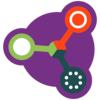Hi @julianstirling
The problem with maps that people make once in a while and maintain once in a while is that they are not dynamic, they are not interconnected and do not present current data. In other words, their value is limited.
But the most problematic thing with the type of maps that you propose is that they will not be maintained. Perhaps you can raise a wave of enthusiasm to produce a few maps. Once the hype is over these maps will be forgotten, they will become outdated and will only serve as historical data. I’ve spent over a decade contributing to open networks and the same pattern comes back over and over again, people don’t like to do support work, i.e. do the boring tasks to maintain the organisation. This is why things need to be automated and interconnected, to reduce to a minimum intervention from people to maintain the network.
The best arrangement is to have the intelligence about the network feed not on data that is manually collected and injected into the system, but from data that is generated as a byproduct of everyone’s activity. An NRP is one type of system that can do that.
You’re right. Adopting a new tool to manage projects and resources is a big deal. You’ve already adopted GitLab. Congratulations. I think it is a good tool for GOSH at this moment.
Formalizing an organisation is not easy… but there are ways to do it, ways to adopt governance, to adopt new tools, to put in place new methodologies of work and event to cultivate a new work culture. One thing is clear though: the more you want to grow and the more complex your activities become the more you need to formalize. The degree of formalization will determine the growth of GOCH. Can’t stay informal and expect GOSH to be able to tackle complex issues.
Imagine someone comes tomorrow and says “I give GOSH $1M to do this”. Without a high degree of formalization, without tools like NRP, without a good governance, the organisation will not be able to accept the offer.
NOTE : formalization doesn’t mean centralization. Bitcoin is highly formal and decentralized at the same time.
So yes, I know, people don’t like to learn new tools, don’t read documentation, … I get it, there is always resistance to adopt something like an NRP. But if GOSH can’t figure out a way to go there the $1M opportunity can’t even be a dream for gosh-ers. Open networks can take on the job of large traditional organisations. We just need to be able to do at least as good of a job as them. They use sophisticated management systems, we need to use them too.
But perhaps GOSH dosn’t have this ambition, which is all fine.
A path of adoption of more sophisticated tools is to use them in paid projects, where people are obliged to do so, in order to be accountable and realiable as a group. In fact, no one will give you a large sum of monay if you don’t show accountability. Usualy open networks use non-profit organizations as interfaces with the funding agencies, to show accountability. A mechanism of fiscal sponsorship is used to transfer fund front the nonprofit to agents in the open network. It works. But in this case the network is subject to whatever the nonprofit says, it is the hand that feed the network, ultimately. Using these tools and other tricks from the OVN book the network can become soverein / autonomous. So there’s a good practical reason to adopt new tools, to be able to tackle lucrative projects. Once adopted by the core of the open network, its use can spread to other types of projects.
Here’s a blog post I wrote about formalization of open networks. Might help continue the conversation…

 so I’m in the process of proving my identity and can’t log in right now, but:
so I’m in the process of proving my identity and can’t log in right now, but: ) can do it without requiring significant time investment from the rest of the community. I would love to hear more about NRP, how much effort is involved, and whether I have totally misunderstood it. But I would assume this would need some serious time investment that would probably mean that it should be pitched to our governance committee once they are more established?
) can do it without requiring significant time investment from the rest of the community. I would love to hear more about NRP, how much effort is involved, and whether I have totally misunderstood it. But I would assume this would need some serious time investment that would probably mean that it should be pitched to our governance committee once they are more established?